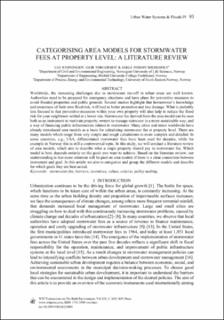| dc.contributor.author | Rydningen, Ulf | |
| dc.contributor.author | Torgersen, Geir | |
| dc.contributor.author | Bjerkholt, Jarle Tommy | |
| dc.date.accessioned | 2022-09-28T11:38:30Z | |
| dc.date.available | 2022-09-28T11:38:30Z | |
| dc.date.created | 2022-09-19T09:20:35Z | |
| dc.date.issued | 2022 | |
| dc.identifier.citation | Rydningen, U., Torgersen, G., & Bjerkholt, J. T. (2022). Categorising area models for stormwater fees at property level: A literature review. WIT Transactions on The Built Environment, 208, 93-105. | en_US |
| dc.identifier.issn | 1746-4498 | |
| dc.identifier.uri | https://hdl.handle.net/11250/3022165 | |
| dc.description.abstract | Worldwide, the increasing challenges due to stormwater run-off in urban areas are well known. Authorities need to be prepared for emergency situations and have plans for preventive measures to avoid flooded properties and public grounds. Several studies highlight that homeowner’s knowledge and awareness of their own flood risk, will lead to better protection and less damage. What is probably less focused is that preventive-measures within your own property will also help to reduce the flood risk for your neighbours settled at a lower site. Stormwater fee derived from the area model can be seen both as an instrument to motivate property owners to manage rainwater in a more sustainable way, and a way of financing public infrastructure related to stormwater. Many cities and states worldwide have already introduced area models as a basis for calculating stormwater fee at property level. There are many models which range from very simple and rough calculations to more complex and detailed. In some countries, e.g., USA, differentiated stormwater fees have been used for decades, while for example in Norway this is still a controversial topic. In this study, we will conduct a literature review of area models, which aim to describe what a single property should pay in stormwater fee. Which model is best, depends entirely on the goals you want to achieve. Based on the literature review, our understanding is that more attention will be paid on area models if there is a clear connection between instrument and goal. In this article we aim to categorize and group the different models and describe for which goals they are best suited. | en_US |
| dc.language.iso | eng | en_US |
| dc.title | Categorising area models for stormwater fees at propert level: A literature review | en_US |
| dc.type | Journal article | en_US |
| dc.description.version | publishedVersion | en_US |
| dc.rights.holder | © 2022 WIT Press. | en_US |
| dc.subject.nsi | VDP::Hydrologi: 454 | en_US |
| dc.subject.nsi | VDP::Hydrology: 454 | en_US |
| dc.subject.nsi | VDP::Hydrologi: 454 | en_US |
| dc.subject.nsi | VDP::Hydrology: 454 | en_US |
| dc.source.pagenumber | 93-105 | en_US |
| dc.source.volume | 208 | en_US |
| dc.source.journal | WIT Transactions on the Built Environment | en_US |
| dc.identifier.doi | https://doi.org/10.2495/FRIAR220081 | |
| dc.identifier.cristin | 2052919 | |
| cristin.ispublished | true | |
| cristin.fulltext | original | |
| cristin.qualitycode | 0 | |
